The Sterlet (Acipenser ruthenus) is a freshwater fish of the genus Sturgeon. It reaches 125 cm in length and weighs 16 kg, usually 40-60 cm and 0.5-2.0 kg. The lower lip is interrupted in the middle. There are more than 50 lateral bugs. The antennae are fringed. Occurs in rivers and reservoirs in the basins of the Caspian, Black, Azov, Baltic and White Seas and the Arctic Ocean. Occurs in Siberian rivers: Ob, Irtysh, Yenisei, Lena. It has been introduced into the Pechora. Lives permanently in riverbeds. Spends the winter in a sedentary state in deep places, does not feed. Sexual maturity is reached in the fourth to ninth year of life. Fecundity varies from 7 to 140 thousand eggs. Spawning is not annual, with intervals of 1-2 years. It lays its eggs in May-June in fast currents on stony and gravelly bottoms. Bentophagous. Feeds on bottom invertebrates (insect larvae, molluscs). Easily crossed with beluga, Russian and Siberian sturgeon and Sevryuga. The most valuable commercial fish. Subject of lake and pond culture and acclimatisation in reservoirs. Transient populations migrating between fresh and salt water have been completely eradicated.
The sterlet is easily distinguished from all other sturgeon by its size, elongated slender snout, long fringed antennae reaching to the mouth, forked lower lip and adjoining lateral shields. Instead of the usual scales, all sturgeons are covered with bony shields arranged in 5 longitudinal rows, of which one occupies the centre of the back, two extend along the sides and two along the edges of the belly; in the gaps between these shields, the skin is either bare or covered with small bony shields of various shapes. In addition, the dorsal shields are closely interlocked; they number 13-17 and each ends with a rather sharp spike behind. The lateral shields are very numerous - 60-70, the abdominal shields 13-15, and the latter do not touch each other. The colour of the sterlet varies from area to area and can be yellow or darker, but usually the back is greyish brown or dark brown, the belly is yellowish white and the fins are grey. The length of the sterlet's nose also varies considerably, and a distinction is made between sharp-nosed and blunt-nosed sterlets.
The sterlet lives mainly in the deepest parts of the river, remaining permanently on the bottom, leading a very secretive life, rarely getting caught in seines and nets in general. Only in the evening or at night does it come out into the shallows - in the grass and on the banks - and searches all the hollows and holes in the banks, or swims up, turning itself upside down and catching insects that fall into the water with its mouth. In addition to depth, many other conditions are necessary; the characteristics of the bottom and the water are very important for the sterlet and cause differences in colour and taste. It avoids slow-flowing, silty, always shallow rivers and never spawns there, only goes there to feed. It likes sandy or cartilaginous bottoms and clean, cool, fast-flowing water.
The main spawning grounds of the sterlet are rocky ridges, i.e. underwater mounds of boulders and rubble, deep and fast-flowing parts of the riverbed itself, covered with coarse sand, gristle, gravel or stones, where many fish eggs are so firmly attached that they cannot be washed away by even the strongest jet of water.
Interesting facts
It is interesting to note that not only during hibernation, but also during any other decrease in vital processes, the oxygen requirement of fish decreases sharply. If you put a piece of absorbent cotton moistened with cognac into the mouth of a sterlet, the fish goes into torpor and can survive for two days without water at low temperatures.
Sterlet
Tags: sterlet


